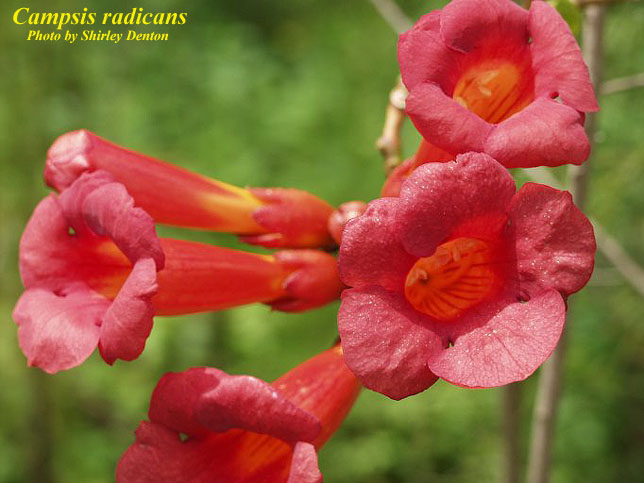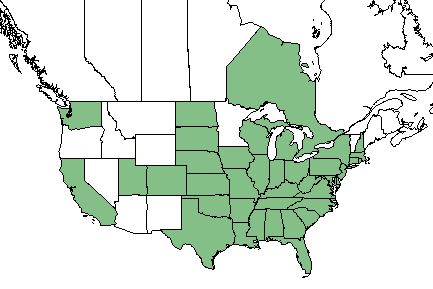Difference between revisions of "Campsis radicans"
(→Description) |
HaleighJoM (talk | contribs) (→Ecology) |
||
| Line 38: | Line 38: | ||
Associated species include ''[[Ampelopsis arborea]]'', ''Celtis laevigata'', and ''Physalis angulata''.<ref name= "Herbarium"/> | Associated species include ''[[Ampelopsis arborea]]'', ''Celtis laevigata'', and ''Physalis angulata''.<ref name= "Herbarium"/> | ||
| − | ===Phenology=== <!--Timing off flowering, fruiting | + | ===Phenology=== <!--Timing off flowering, fruiting, and environmental triggers. Cite PanFlora website if appropriate: http://www.gilnelson.com/PanFlora/ --> |
''C. radicans'' has been observed flowering from April to August with peak inflorescence in May.<ref name= "PanFlora"> Nelson, G. PanFlora: Plant data for the eastern United States with emphasis on the Southeastern Coastal Plains, Florida, and the Florida Panhandle. www.gilnelson.com/PanFlora/ Accessed: 16 MAY 2018 </ref> | ''C. radicans'' has been observed flowering from April to August with peak inflorescence in May.<ref name= "PanFlora"> Nelson, G. PanFlora: Plant data for the eastern United States with emphasis on the Southeastern Coastal Plains, Florida, and the Florida Panhandle. www.gilnelson.com/PanFlora/ Accessed: 16 MAY 2018 </ref> | ||
===Seed dispersal=== | ===Seed dispersal=== | ||
This species is thought to be dispersed by wind.<ref> Kirkman, L. Katherine. Unpublished database of seed dispersal mode of plants found in Coastal Plain longleaf pine-grasslands of the Jones Ecological Research Center, Georgia.</ref><ref name= "Creech">Creech, M. N., et al. (2012). "Alteration and Recovery of Slash Pile Burn Sites in the Restoration of a Fire-Maintained Ecosystem." Restoration Ecology 20(4): 505-516.</ref> | This species is thought to be dispersed by wind.<ref> Kirkman, L. Katherine. Unpublished database of seed dispersal mode of plants found in Coastal Plain longleaf pine-grasslands of the Jones Ecological Research Center, Georgia.</ref><ref name= "Creech">Creech, M. N., et al. (2012). "Alteration and Recovery of Slash Pile Burn Sites in the Restoration of a Fire-Maintained Ecosystem." Restoration Ecology 20(4): 505-516.</ref> | ||
| + | |||
<!--===Seed bank and germination===--> | <!--===Seed bank and germination===--> | ||
| Line 48: | Line 49: | ||
''C. radicans'' is not fire resistant, but has a high fire tolerance. <ref name= "USDA Plant Database"/> | ''C. radicans'' is not fire resistant, but has a high fire tolerance. <ref name= "USDA Plant Database"/> | ||
| − | ===Pollination | + | ===Pollination=== |
| − | Due to this species producing large quantities of nectar and the tubular shape of the flowers, ''C. radicans'' attracts various hummingbirds, such as the ruby-throated hummingbird, as well as butterflies.<ref name= "Fact sheet"/> It is also known to be pollinated by long tongued bees.<ref name= "Lady bird">[[https://www.wildflower.org/plants/search.php?search_field=&newsearch=true]] Lady Bird Johnson Wildflower Center. Accessed: March 29, 2019</ref> Fly species of the Syrphidae and Tachinidae (Diptera) families have been collected on the plant.<ref name= "Tooker">Tooker, J. F., et al. (2006). "Floral host plants of Syrphidae and Tachinidae (Diptera) of central Illinois." Annals of the Entomological Society of America 99(1): 96-112.</ref> | + | Due to this species producing large quantities of nectar and the tubular shape of the flowers, ''C. radicans'' attracts various hummingbirds, such as the ruby-throated hummingbird, as well as butterflies.<ref name= "Fact sheet"/> It is also known to be pollinated by long tongued bees.<ref name= "Lady bird">[[https://www.wildflower.org/plants/search.php?search_field=&newsearch=true]] Lady Bird Johnson Wildflower Center. Accessed: March 29, 2019</ref> Fly species of the Syrphidae and Tachinidae (Diptera) families have been collected on the plant.<ref name= "Tooker">Tooker, J. F., et al. (2006). "Floral host plants of Syrphidae and Tachinidae (Diptera) of central Illinois." Annals of the Entomological Society of America 99(1): 96-112.</ref> |
| + | |||
| + | ===Herbivory and toxicology=== | ||
| + | ''C. radicans'' has been observed that this species hosts snout-nosed moths such as ''Clydonopteron sacculana'' (family Pyralidae) and planthoppers such as ''Micrutalis calva'' (family Pyralidae).<ref>Discoverlife.org [https://www.discoverlife.org/20/q?search=Bidens+albaDiscoverlife.org|Discoverlife.org]</ref> ''C. radicans'' is an occasional food source for large mammals and terrestrial birds. <ref name= "USDA Plant Database"> USDA Plant Database [https://plants.usda.gov/core/profile?symbol=CARA2 https://plants.usda.gov/core/profile?symbol=CARA2] </ref> However, coming into contact with the leaves and flowers can result in skin redness and swelling for mammals, and is slightly toxic if ingested. The flower provides nectar for hummingbirds and butterflies, and the vines provide habitat for ants.<ref name= "Fact sheet">Wennerberg, S. (2006). Plant Fact Sheet: Trumpet Creeper ''Campsis radicans''. N.R.C.S. United States Department of Agriculture. Baton Rouge, LA. </ref> Ruby-throated Hummingbirds feed on the flower nectar and American Goldfinches feed on the seeds.<ref>Doukas A. 1993. Trumpet Creeper. Palmetto 13(4):24.</ref> It is a larval host for the Plebeian sphinx (''Paratrea plebeja'').<ref name= "Lady bird"/> | ||
===Diseases and parasites=== | ===Diseases and parasites=== | ||
Revision as of 20:18, 15 June 2022
Common name: Trumpet Creeper [1]
| Campsis radicans | |
|---|---|

| |
| Photo by the Atlas of Florida Plants Database | |
| Scientific classification | |
| Kingdom: | Plantae |
| Division: | Magnoliophyta - Flowering plants |
| Class: | Magnoliopsida - Dicots |
| Order: | Scrophulariales |
| Family: | Bignoniaceae |
| Genus: | Campsis |
| Species: | C. radicans |
| Binomial name | |
| Campsis radicans L | |

| |
| Natural range of Campsis radicans from USDA NRCS Plants Database. | |
Contents
Taxonomic Notes
Synonyms: Bignonia radicans Linnaeus.[2]
Varieties: none.[2]
Description
C. radicans is a perennial vine of the Bignoniaceae family native to North America and Canada.[1] It is partly evergreen or deciduous, and climbs through aerial rootlets and twining stems that can reach lengths of up to 12 m long. The leaves are oppositely arranged, somewhat shiny and dark green in color, coarsely toothed and pinnately compound, with 7 - 11 leaflets. The flowers are red to yellow-orange, tubular shaped, get up to 8 cm long and 4 cm wide (widest at the mouth), and are arranged in sets of 4 - 12. The fruit is a capsule, flat and tapered, with flat and winged seeds.[3] The foliage of C. radicans can often be seen in canopies of 30 - 40 meters in height, and with stems up to 15 centimeters in diameter. C. radicans is easily recognizable by its tannish, shreddy bark. [4]
Distribution
C. radicans is found in the Ontario region of Canada, the eastern half of the United States, California, and Washington. [1]
Ecology
Habitat
C. radicans was primarily limited to swamps and bottomlands in the pre-Columbian landscape, and has become a successful colonizer of abandoned farmland, fencerows, and thickets. [4] It has also been observed in floodplain forests and the edges of floodplain forests, loess bluffs, and river banks.[5]
C. radicans has shown regrowth in reestablished longleaf pine woodlands that underwent agriculture-based soil disturbance in South Carolina, making it an indicator species for post-agricultural woodland.[6]
Associated species include Ampelopsis arborea, Celtis laevigata, and Physalis angulata.[5]
Phenology
C. radicans has been observed flowering from April to August with peak inflorescence in May.[7]
Seed dispersal
This species is thought to be dispersed by wind.[8][9]
Fire ecology
C. radicans is not fire resistant, but has a high fire tolerance. [1]
Pollination
Due to this species producing large quantities of nectar and the tubular shape of the flowers, C. radicans attracts various hummingbirds, such as the ruby-throated hummingbird, as well as butterflies.[3] It is also known to be pollinated by long tongued bees.[10] Fly species of the Syrphidae and Tachinidae (Diptera) families have been collected on the plant.[11]
Herbivory and toxicology
C. radicans has been observed that this species hosts snout-nosed moths such as Clydonopteron sacculana (family Pyralidae) and planthoppers such as Micrutalis calva (family Pyralidae).[12] C. radicans is an occasional food source for large mammals and terrestrial birds. [1] However, coming into contact with the leaves and flowers can result in skin redness and swelling for mammals, and is slightly toxic if ingested. The flower provides nectar for hummingbirds and butterflies, and the vines provide habitat for ants.[3] Ruby-throated Hummingbirds feed on the flower nectar and American Goldfinches feed on the seeds.[13] It is a larval host for the Plebeian sphinx (Paratrea plebeja).[10]
Diseases and parasites
C. radicans is a host plant for Field Dodder (Cuscuta campestris), and Cuscuta pentagona.[14]
Diseases and parasites
Diseases include leaf spots caused by various fungi, and mildew that causes white powdery growth that can be found on the leaves.[3]
Conservation, cultivation, and restoration
C. radicans is listed as a weedy or invasive species by The University Press of Kentucky, the Cornell University Press, and the Southern Weed Science Society. [1] To combat this, the vines should be thinned throughout the growing season as well as cut back in the winter to stop aggressive spread.[3] Cultivars used for ornamental purposes include 'Atropurpurea', 'Crimson trumpet', 'Flamenco', 'Flava', 'Madame Galen', 'Minor', 'Praecox', 'Speciosa', and 'Variegata'.[3]
Cultural use
Photo Gallery
References and notes
- ↑ 1.0 1.1 1.2 1.3 1.4 1.5 USDA Plant Database https://plants.usda.gov/core/profile?symbol=CARA2
- ↑ 2.0 2.1 Weakley, A.S. 2015. Flora of the southern and mid-atlantic states. Working Draft of 21 May 2015. University of North Carolina at Chapel Hill, Chapel Hill, North Carolina.
- ↑ 3.0 3.1 3.2 3.3 3.4 3.5 Wennerberg, S. (2006). Plant Fact Sheet: Trumpet Creeper Campsis radicans. N.R.C.S. United States Department of Agriculture. Baton Rouge, LA.
- ↑ 4.0 4.1 Weakley, A. S. (2015). Flora of the Southern and Mid-Atlantic States. Chapel Hill, NC, University of North Carolina Herbarium.
- ↑ 5.0 5.1 Florida State University Robert K. Godfrey Herbarium database. URL: http://herbarium.bio.fsu.edu. Last accessed: March 2019. Collectors: Jame Amoroso, Loran C. Anderson, Kurt E. Blum, Michael B. Brooks, R. Buchanan, Andre F. Clewell, R. F. Doren, Wm. H. Ellis, Robert K. Godfrey, Norlan C. Henderson, Brenda Herring, Clarke Hudson, Ed Keppner, Lisa Keppner, R. Komarek, Elmo Law, S. J. Lombardo, Karen MacClendon, Sidney McDaniel, Richard S. Mitchell, J. B. Nelson, R. A. Norris, Sara J. Noyes, Kevin Oakes, Elmer C. Prichard, A. E. Radford, Gwynn W. Ramsey, Paul L. Redfearn, Jr., R. R. Smith, Charles S. Wallis, D. B. Ward, S. S. Ward, Roomie Wilson, D. R. Windler, and Jean W. Wooten. States and Counties: Florida: Bay, Calhoun, Columbia, Dixie, Franklin, Gadsden, Gulf, Jackson, Jefferson, Leon, Liberty, Madison, Suwannee, Taylor, Volusia, Wakulla, and Washington. Georgia: Grady. Illinois: White. Kansas: Allen. Louisiana: Lafayette and Tangipahoa. Maryland: Cecil. Mississippi: Jackson and Wilkinson. Missouri: Douglas. North Carolina: Caldwell. Oklahoma: Latimer. South Carolina: Oconee. Tennessee: Rutherford. Texas: Knox and Taylor.
- ↑ Brudvig, L.A., E Grman, C.W. Habeck, and J.A. Ledvina. (2013). Strong legacy of agricultural land use on soils and understory plant communities in longleaf pine woodlands. Forest Ecology and Management 310: 944-955.
- ↑ Nelson, G. PanFlora: Plant data for the eastern United States with emphasis on the Southeastern Coastal Plains, Florida, and the Florida Panhandle. www.gilnelson.com/PanFlora/ Accessed: 16 MAY 2018
- ↑ Kirkman, L. Katherine. Unpublished database of seed dispersal mode of plants found in Coastal Plain longleaf pine-grasslands of the Jones Ecological Research Center, Georgia.
- ↑ Creech, M. N., et al. (2012). "Alteration and Recovery of Slash Pile Burn Sites in the Restoration of a Fire-Maintained Ecosystem." Restoration Ecology 20(4): 505-516.
- ↑ 10.0 10.1 [[1]] Lady Bird Johnson Wildflower Center. Accessed: March 29, 2019
- ↑ Tooker, J. F., et al. (2006). "Floral host plants of Syrphidae and Tachinidae (Diptera) of central Illinois." Annals of the Entomological Society of America 99(1): 96-112.
- ↑ Discoverlife.org [2]
- ↑ Doukas A. 1993. Trumpet Creeper. Palmetto 13(4):24.
- ↑ Musselman, L. J. (1986). "The genus Cuscuta in Virginia." Castanea 51(3): 188-196.